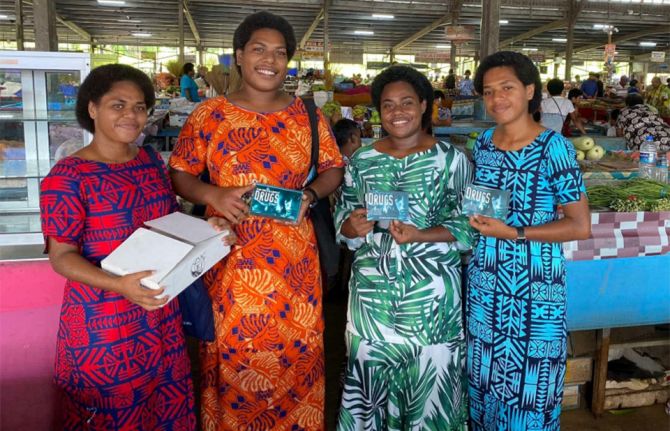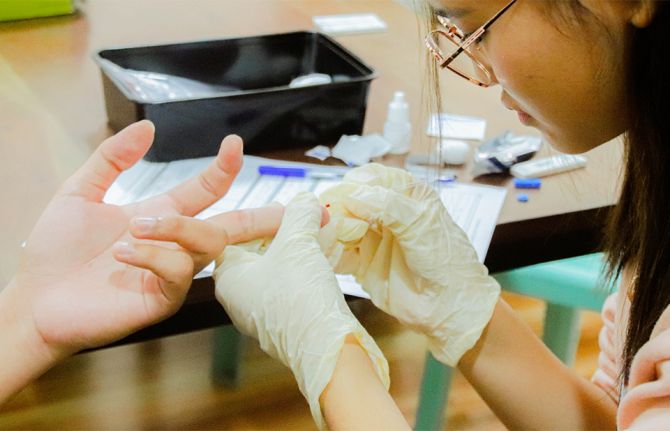
Feature Story
Eight-year trend shows new HIV infections down by 17%—most progress seen in sub-Saharan Africa
24 November 2009
24 November 2009 24 November 2009Efforts towards universal access to HIV prevention, treatment, care and support are bringing AIDS out of isolation

UNAIDS Executive Director Michel Sidibé launches double report in Shanghai, 24 November 2009.
Credit: UNAIDS
Geneva / Shanghai, 24 November 2009 – According to new data in the 2009 AIDS epidemic update, new HIV infections have been reduced by 17% over the past eight years. Since 2001, when the United Nations Declaration of Commitment on HIV/AIDS was signed, the number of new infections in sub-Saharan Africa is approximately 15% lower, which is about 400,000 fewer infections in 2008. In East Asia new HIV infections declined by nearly 25% and in South and South East Asia by 10% in the same time period. In Eastern Europe, after a dramatic increase in new infections among injecting drug users, the epidemic has leveled off considerably. However, in some countries there are signs that new HIV infections are rising again.

Credit: UNAIDS
The report, released today by the Joint United Nations Programme on HIV/AIDS (UNAIDS) and the World Health Organization (WHO), highlights that beyond the peak and natural course of the epidemic—HIV prevention programmes are making a difference.
“The good news is that we have evidence that the declines we are seeing are due, at least in part, to HIV prevention,” said Michel Sidibé, Executive Director of UNAIDS. “However, the findings also show that prevention programming is often off the mark and that if we do a better job of getting resources and programmes to where they will make most impact, quicker progress can be made and more lives saved.”
In this first double issue, the UNAIDS Outlook report further explores how “modes of transmission” studies are changing the approach of HIV prevention efforts. The new magazine-style report looks at new ideas and ways to use the data collected in the companion epidemiological report.
An estimated:
- 33.4 million [31.1 million–35.8 million] people are living with HIV worldwide
- 2.7 million [2.4 million–3.0 million] people were newly infected in 2008
- 2 million [1.7– 2.4 million] people died of AIDS related illness in 2008
Universal access to HIV prevention, treatment, care and support

photo caption. Credit:
Data from the AIDS Epidemic Update also show that at 33.4 million, [31.1 million–35.8 million] there are more people living with HIV than ever before as people are living longer due to the beneficial effects of antiretroviral therapy and population growth. However the number of AIDS-related deaths has declined by over 10% over the past five years as more people gained to access to the life saving treatment. UNAIDS and WHO estimate that since the availability of effective treatment in 1996, some 2.9 million lives have been saved.
"International and national investment in HIV treatment scale-up have yielded concrete and measurable results,” said Dr Margaret Chan, Director General of WHO. “We cannot let this momentum wane. Now is the time to redouble our efforts, and save many more lives."
Antiretroviral therapy has also made a significant impact in preventing new infections in children as more HIV- positive mothers gain access to treatment preventing them from transmitting the virus to their children. Around 200 000 new infections among children have been prevented since 2001.
In Botswana, where treatment coverage is 80%, AIDS-related deaths have fallen by over 50% over the past five years and the number of children newly orphaned is also coming down as parents are living longer.
AIDS out of isolation
One of the significant findings of the report is that the impact of the AIDS response is high where HIV prevention and treatment programmes have been integrated with other health and social welfare services. Early evidence shows that HIV may be a significant factor in maternal mortality. Research models using South African data estimate that about 50,000 maternal deaths were associated with HIV in 2008.
“AIDS isolation must end,” said Mr Sidibé. “Already research models are showing that HIV may have a significant impact on maternal mortality. Half of all maternal deaths in Botswana and South Africa are due to HIV. This tells us that we must work for a unified health approach bringing maternal and child health and HIV programmes as well as tuberculosis programmes together to work to achieve their common goal.”
The AIDS epidemic is evolving and HIV prevention programmes are not rapidly adjusting to the changes
The double report also shows that the face of the epidemic is changing and that prevention efforts are not keeping pace with this shift. For example the epidemic in Eastern Europe and Central Asia once characterized by injecting drug use is now spreading to the sexual partners of people who inject drugs. Similarly in parts of Asia an epidemic once characterized by transmission through sex work and injecting drug use is now increasingly affecting heterosexual couples.
Data show that few HIV prevention programmes exist for people over 25, married couples or people in stable relationships, widowers and divorcees. These are the same groups in which HIV prevalence has been found to be high in many sub-Saharan countries. For example in Swaziland people over the age of 25 accounted for more than two thirds of adult infections yet very few HIV prevention programmes are designed for older people.
Funding for HIV prevention has become the smallest percentage of the HIV budgets of many countries. For example in Swaziland, just 17% of the country’s total budget for AIDS was spent on prevention despite a national HIV prevalence rate of 26%. In Ghana, the prevention budget was cut in 2007 by 43% from 2005 levels.
Building capacity: new social networking site for global AIDS community
Building on the need to maximize results and to better connect the 33.4 million people living with HIV and the millions of people who are part of the AIDS response, UNAIDS has launched AIDSspace.org. This social networking site is open to the community and is free.
AIDSspace.org aims to expand informal and established networks to include more people interested in HIV to maximize resources for a stronger AIDS response. The premise behind AIDSspace is simple: if hundreds of millions of people can connect on some of the most popular social networking sites (e.g. Facebook, LinkedIn, MySpace, Twitter, YouTube) to connect, exchange ideas, post and share HIV-related content, they can do the same for HIV related content—including key policies, case studies, multimedia materials, conference posters, reports and other essential resources. Users can also find and post jobs and reviews on service providers on AIDSspace.org
Press conference launch of two publications, Shanghai, 24 November 2009.
Speakers from left) Ms Annemarie Hou, Director Communicaitons UNAIDS; Mr Michel Sidibé, Executive Director, UNAIDS; Dr Chen Zhu, Chinese Minister of Health; Dr Hiroki Nakatani, Assistant Director General, AIDS, TB, Malaria and Neglected Tropical Diseases, WHO; Ms Zhao Chunki, Social worker.
UNAIDS is an innovative joint venture of the United Nations, bringing together the efforts and resources of the UNAIDS Secretariat and ten UN system organizations in the AIDS response. The Secretariat headquarters is in Geneva, Switzerland—with staff on the ground in more than 80 countries. The Cosponsors include UNHCR, UNICEF, WFP, UNDP, UNFPA, UNODC, ILO, UNESCO, WHO and the World Bank. Contributing to achieving global commitments to universal access to comprehensive interventions for HIV prevention, treatment, care and support is the number one priority for UNAIDS. Visit the UNAIDS website at www.unaids.org
The World Health Organization (WHO) is the directing and coordinating authority for health within the United Nations system. It is responsible for providing leadership on global health matters, shaping the health research agenda, setting norms and standards, articulating evidence-based policy options, providing technical support to countries and monitoring and assessing health trends. For more information, please visit www.who.int
AIDSspace.org is an online community for connecting people, sharing knowledge, and accessing services for the 33.4 million people living with HIV and the millions who are part of the response. Sign up today at www.aidsspace.org
Eight-year trend shows new HIV infections down by
Cosponsors:
Press centre:
Download printable PDF (pdf)
Multimedia from press conference launches in Shanghai and Geneva (24 November 2009)
Feature stories:
UNAIDS Outlook 2010: Fresh perspective on the AIDS epidemic and response (24 November 2009)
Contact:
Sophie Barton-Knott
Tel: +41 22 791 1697
Email: bartonknotts@unaids.org
Publications:
2009 AIDS Epidemic Update (pdf, 3 mb)
Corrigendum to version downloaded before 25 November 14:00
UNAIDS Outlook 2010 (pdf, 4 mb)



